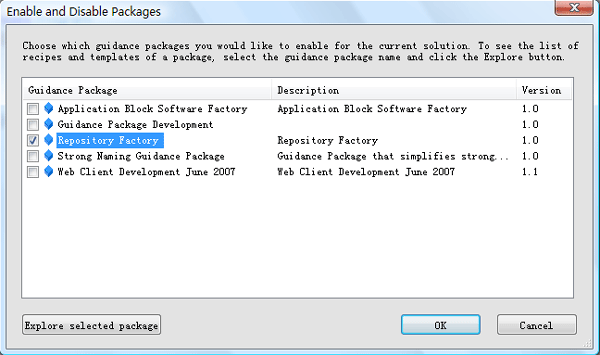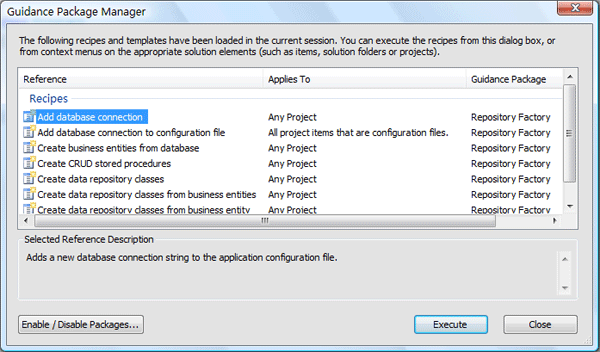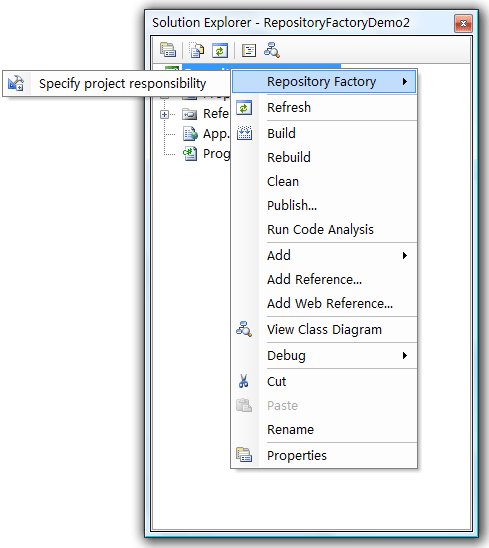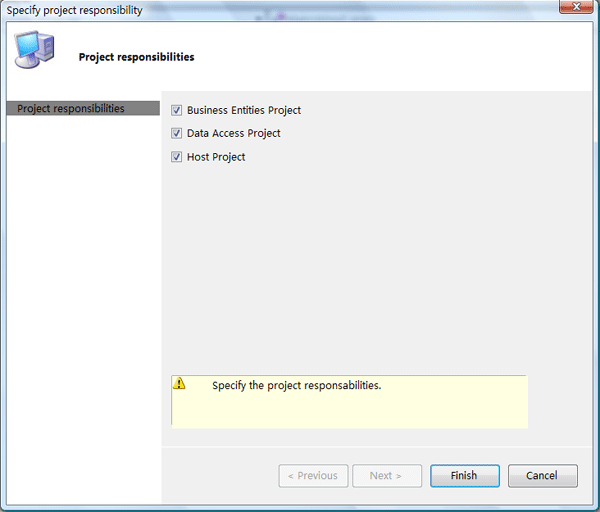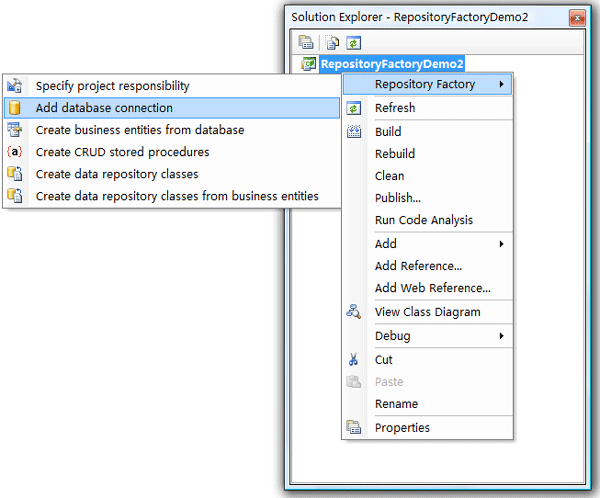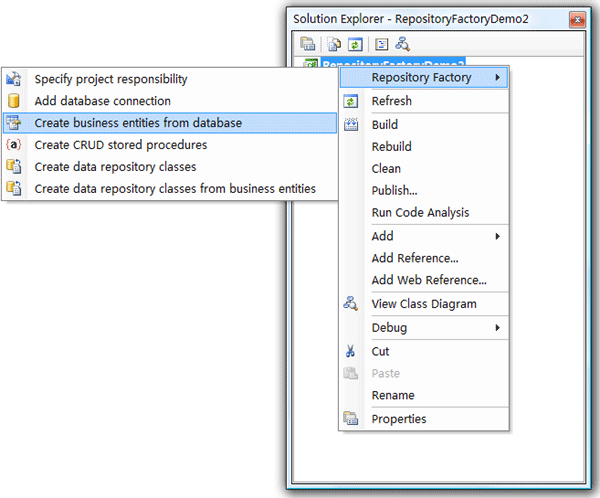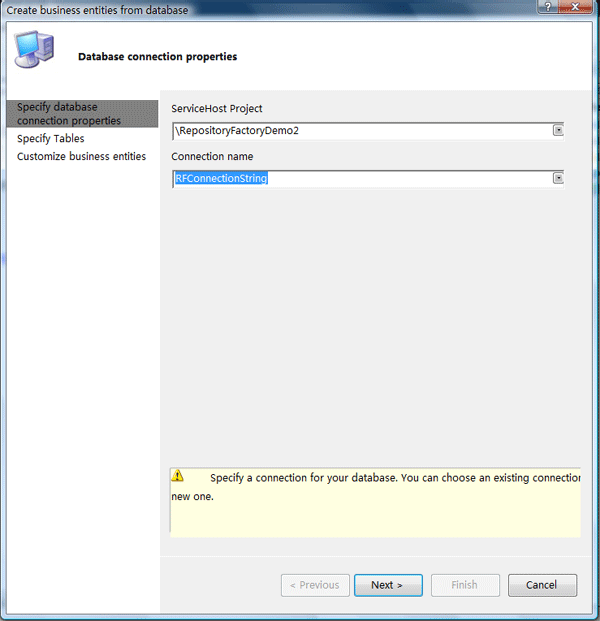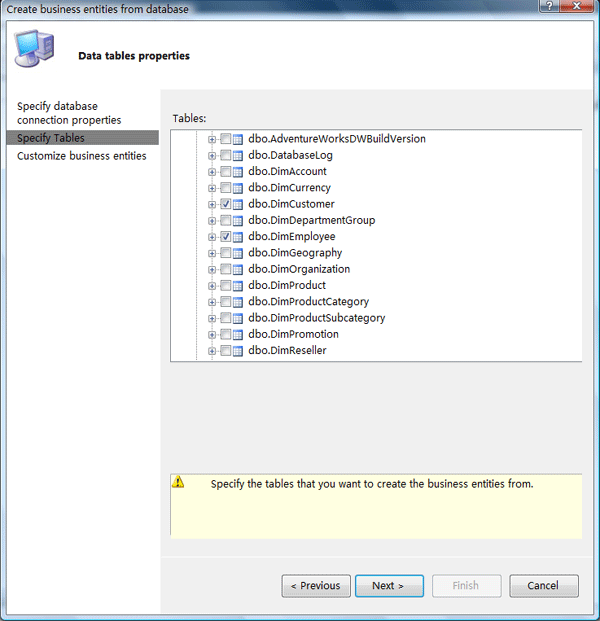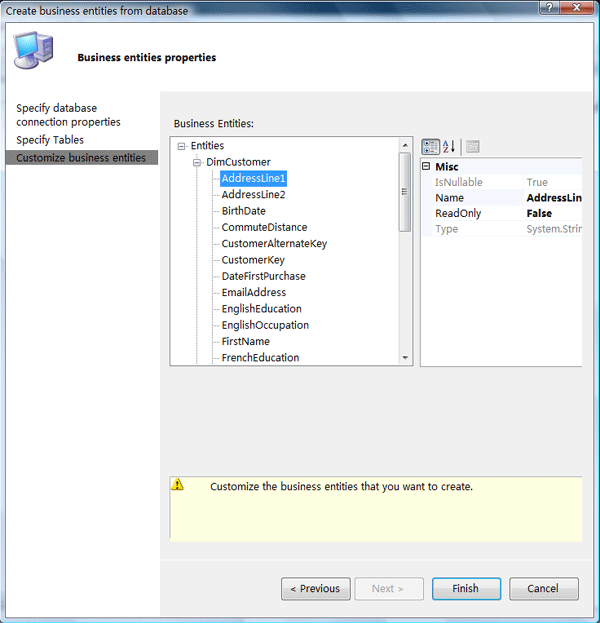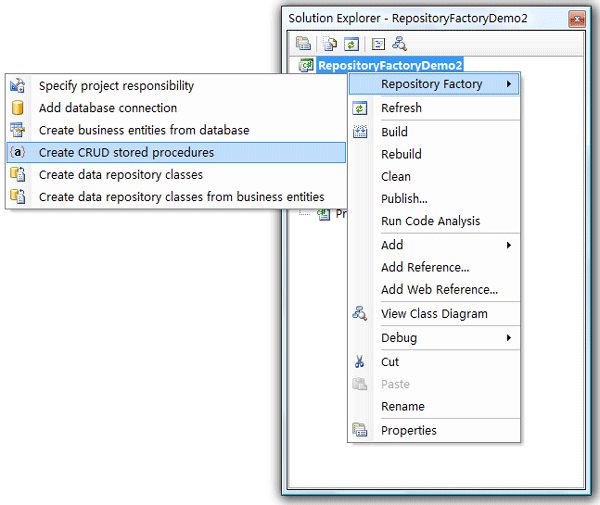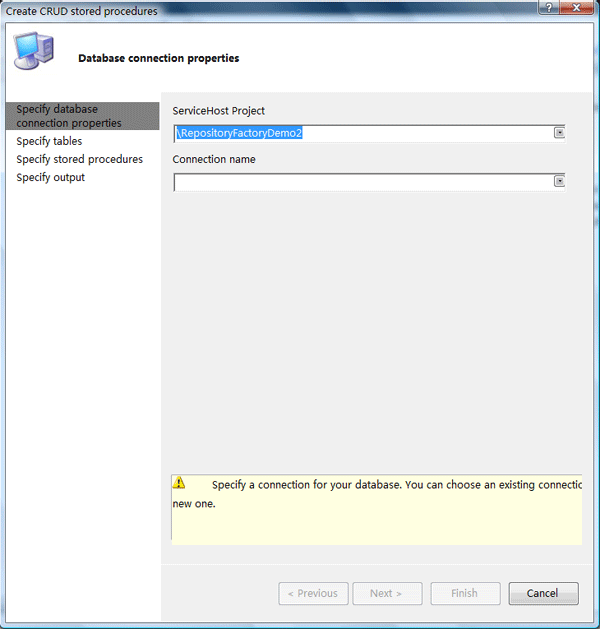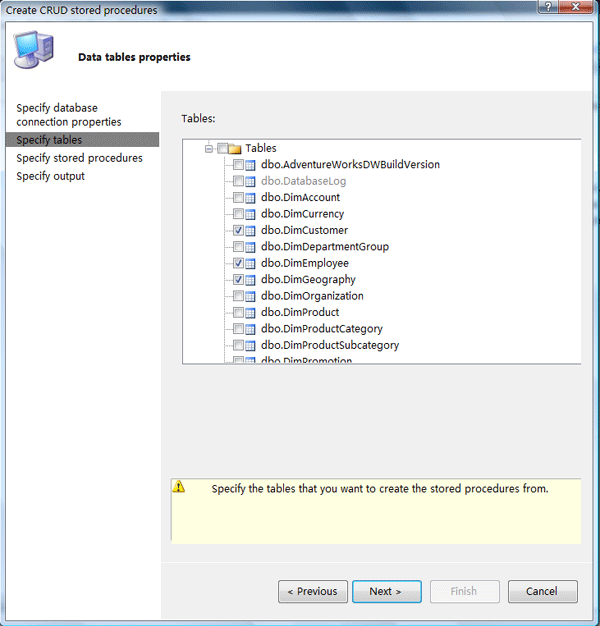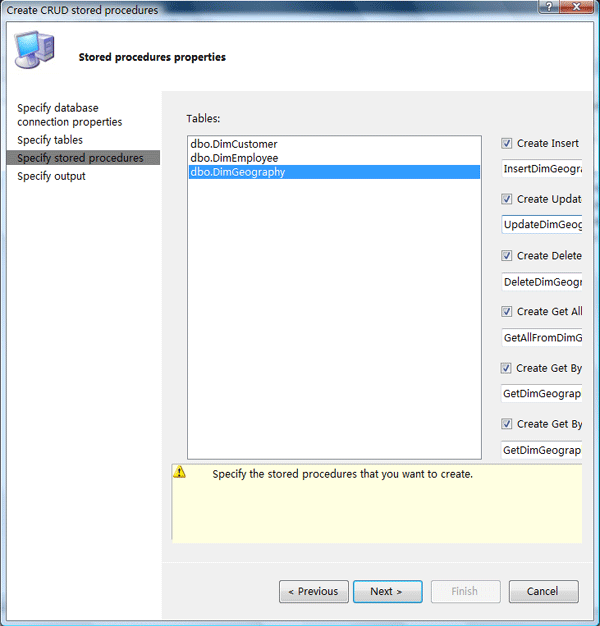微软轻量级“代码生成器”—Repository Factory使用(上)
概述
Repository Factory是微软模式与实践小组发布的一个开发指南包,它把之前的Web Service Software Factory(WSSF)集成的Data Access Guidance Package分离出来,形成了一个单独的开发指南包。引用Johnny Halife的话说:“它不是一个对象-关系映射(Object-Relational Mapping,ORM)工具,它的目的是作为一个轻量级的代码生成器,以自动化完成绝大部分生成领域模型对象,并将之持久化到数据库的任务代码。”本文为微软轻量级“代码生成器”—Repository Factory使用上篇。
Johnny指出了Repository Factory的改进之处:
1.开发包被移植到GAT/GAX上。
2.对WSSF的依赖全部移除,因此Repository Factory现在是一个完全独立的指南开发包。
3.之前由开发包生成并且包含多个基类的通用代码,现在被打包成为一个独立的DLL,并由Repository Factory项目引用。
4.生成了一个通用基本接口,来支持IOC模式。
5.除通用基本接口外,还生成了一个Factory类,并可以在项目配置文件中进行配置。因此,Repository Factory的实现方式可以通过修改配置文件切换。
6.为自定义存储操作的方便,加入了从实体字段到存储过程参数的自动映射。
7.数据库名称和配置从生成的Repository移植到了Repository<T>基类,连接字符串定义在配置文件中。
8.Repository方案的设置(操作和映射)现在可以保存起来以供重用。
下载安装
可以到RepositoryFactory官方主页上下载最新版本:http://www.codeplex.com/RepositoryFactory
注意安装之前请确保安装:
1.Guidance Automation Extensions
2.Guidance Automation Toolkit
启用RepositoryFactory
Step1:在Visual Studio 2005工具菜单中,选择Guidance Package Manager,可以打开指导包管理器:
Step2:选择Repository Factory
Step3:同时还需要在项目上右键菜单中,选择Specify project responsibility
Step4:分别选择Business Entities Project、Data Access Project、Host Project。
添加数据库连接
Step1:接下来需要添加数据库连接
Step2:输入数据库连接串的名称:
创建连接完成后,将会在配置文件添加代码:
<connectionStrings> <add name="RFConnectionString" connectionString="Data Source=Esint-lhj\Sql2005;Initial Catalog=AdventureWorksDW;Persist Security Info=True;User ID=sa;Password=" providerName="System.Data.SqlClient" /> </connectionStrings>
创建实体类
用Repository Factory可以很方便的通过数据库架构,生成业务实体的代码。
Step1:创建业务实体
Step2:选择数据库连接字符串
Step3:选择数据表、视图和字段
Step4:设置实体的属性了,可以设置业务实体的名称,默认的是表名;设置业务实体的属性名和该属性是否为只读属性
点击完成后,会生成业务实体的代码,并且为局部类型,这样便于用户在该业务实体上添加自己的一些操作,示例代码如下:
public partial class DimGeography { public DimGeography() { } public DimGeography(System.String city, System.String countryRegionCode, System.String englishCountryRegionName,
System.String frenchCountryRegionName, System.Int32 geographyKey, System.String postalCode,
Nullable<System.Int32> salesTerritoryKey, System.String spanishCountryRegionName, System.String stateProvinceCode,
System.String stateProvinceName) { this.cityField = city; this.countryRegionCodeField = countryRegionCode; this.englishCountryRegionNameField = englishCountryRegionName; this.frenchCountryRegionNameField = frenchCountryRegionName; this.geographyKeyField = geographyKey; this.postalCodeField = postalCode; this.salesTerritoryKeyField = salesTerritoryKey; this.spanishCountryRegionNameField = spanishCountryRegionName; this.stateProvinceCodeField = stateProvinceCode; this.stateProvinceNameField = stateProvinceName; } private System.String cityField; public System.String City { get { return this.cityField; } set { this.cityField = value; } } private System.String countryRegionCodeField; public System.String CountryRegionCode { get { return this.countryRegionCodeField; } set { this.countryRegionCodeField = value; } } private System.String englishCountryRegionNameField; public System.String EnglishCountryRegionName { get { return this.englishCountryRegionNameField; } set { this.englishCountryRegionNameField = value; } } private System.String frenchCountryRegionNameField; public System.String FrenchCountryRegionName { get { return this.frenchCountryRegionNameField; } set { this.frenchCountryRegionNameField = value; } } private System.Int32 geographyKeyField; public System.Int32 GeographyKey { get { return this.geographyKeyField; } set { this.geographyKeyField = value; } } private System.String postalCodeField; public System.String PostalCode { get { return this.postalCodeField; } set { this.postalCodeField = value; } } private Nullable<System.Int32> salesTerritoryKeyField; public Nullable<System.Int32> SalesTerritoryKey { get { return this.salesTerritoryKeyField; } set { this.salesTerritoryKeyField = value; } } private System.String spanishCountryRegionNameField; public System.String SpanishCountryRegionName { get { return this.spanishCountryRegionNameField; } set { this.spanishCountryRegionNameField = value; } } private System.String stateProvinceCodeField; public System.String StateProvinceCode { get { return this.stateProvinceCodeField; } set { this.stateProvinceCodeField = value; } } private System.String stateProvinceNameField; public System.String StateProvinceName { get { return this.stateProvinceNameField; } set { this.stateProvinceNameField = value; } } }
创建CRUD的存储过程
利用Repository Factory可以很方便的生成针对数据表的CRUD存储过程,可以生成Insert、Update、Delete、GetAll、GetOne、GetMany六种类型的存储过程。
Step1:选择Create CRUD Stored Procedures菜单
Step2:仍然是选择连接
Step3:选择要生成存储过程的数据表
Step4:设置是否生成上面所说的六种存储过程以及存储过程的名称
Step5:设置存储过程的输出文件
生成的存储过程部分代码:
---------------------------------------------------------------- -- [dbo].[DimGeography] Table -- IF NOT EXISTS (SELECT NAME FROM sys.objects WHERE TYPE = 'P' AND NAME = 'InsertDimGeography') BEGIN EXEC('CREATE PROCEDURE [dbo].[InsertDimGeography] AS RETURN') END GO ALTER PROCEDURE [dbo].[InsertDimGeography] @city nvarchar(30) = NULL, @countryRegionCode nvarchar(3) = NULL, @englishCountryRegionName nvarchar(50) = NULL, @frenchCountryRegionName nvarchar(50) = NULL, @geographyKey int OUT, @postalCode nvarchar(15) = NULL, @salesTerritoryKey int, @spanishCountryRegionName nvarchar(50) = NULL, @stateProvinceCode nvarchar(3) = NULL, @stateProvinceName nvarchar(50) = NULL AS BEGIN SET NOCOUNT ON BEGIN TRY INSERT INTO [dbo].[DimGeography] ([City], [CountryRegionCode], [EnglishCountryRegionName], [FrenchCountryRegionName], [PostalCode], [SalesTerritoryKey], [SpanishCountryRegionName], [StateProvinceCode], [StateProvinceName]) VALUES (@city, @countryRegionCode, @englishCountryRegionName, @frenchCountryRegionName, @postalCode, @salesTerritoryKey, @spanishCountryRegionName, @stateProvinceCode, @stateProvinceName) SET @geographyKey = SCOPE_IDENTITY() END TRY BEGIN CATCH EXEC RethrowError; END CATCH SET NOCOUNT OFF END GO
结束语
使用Repository Factory生成业务实体和存储过程,就介绍到这里,限于篇幅,分成了上下两篇,其他内容放在微软轻量级“代码生成器”—Repository Factory使用(下)。
参考:微软轻量级“代码生成器”—Repository Factory使用(下)
Worktile,新一代简单好用、体验极致的团队协同、项目管理工具,让你和你的团队随时随地一起工作。完全免费,现在就去了解一下吧。
https://worktile.com

